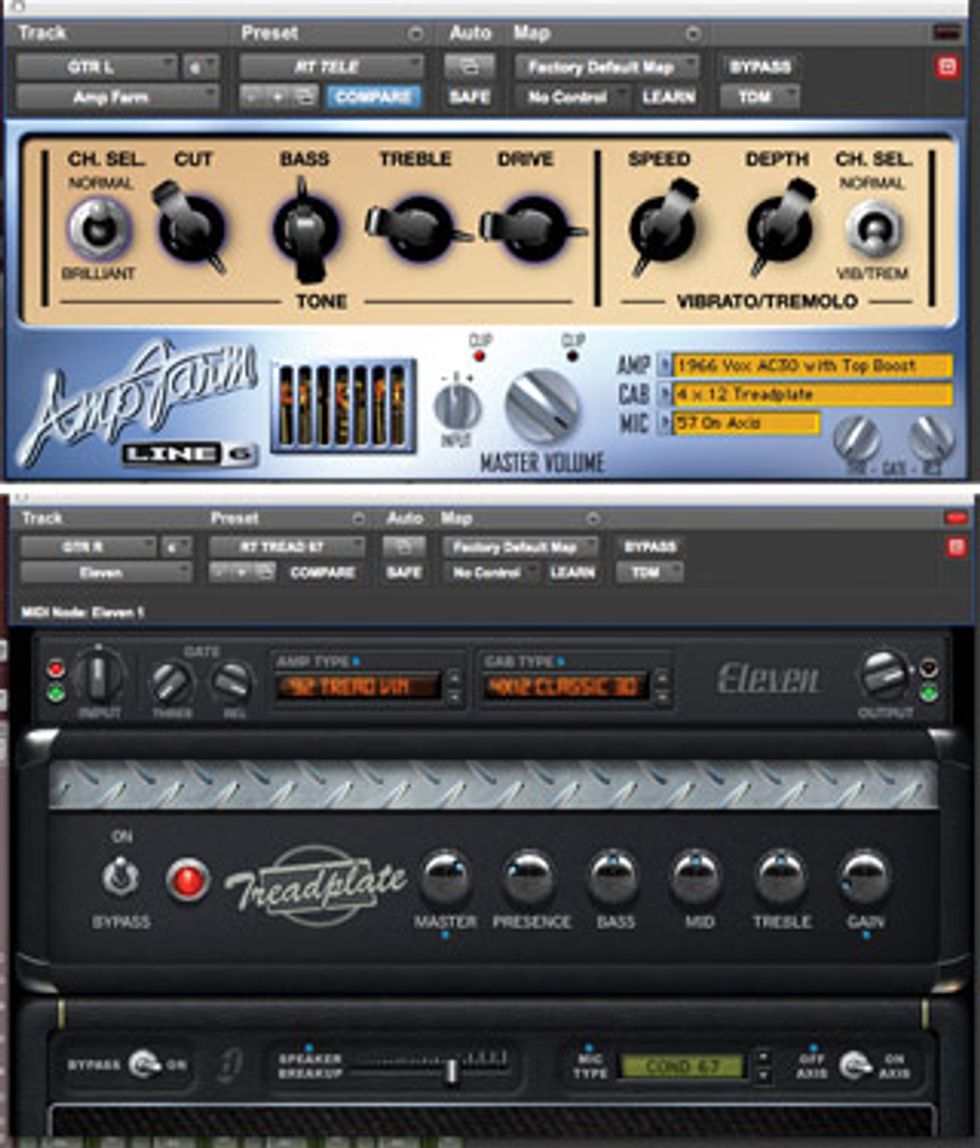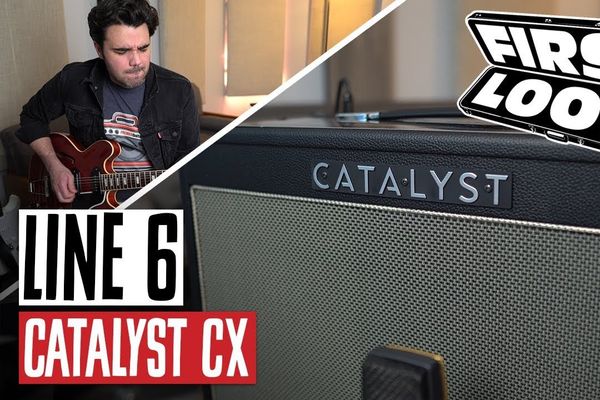I’ve amassed a small but very useful amp collection that actually has a lot to do with plug-ins.

Top: Line 6’s Amp Farm modeling a 1966 Vox AC30 mic’d by a Shure SM57.
Bottom: Used creatively, the Treadplate amp simulator in Avid’s Eleven Rack can deliver convincing high-gain tones.
Over the years, I’ve had a lot of experience recording with both real guitar amps and amp plug-ins. In this column, I’d like to share some of the pros and cons of each as they relate to real-world studio production.
When I first started playing, I was lucky enough to plug into some nice tube amps, so I grew up with the sound of glowing filaments and that particular give-and-take that only a good, nuts-and-bolts amp can deliver. Since then, I’ve amassed a small but very useful amp collection that actually has a lot to do with plug-ins.
Here’s what I mean: I’ve found that plug-ins do a good job of emulating Fenders, Marshalls, and some heavier-gain amps by Soldano and Mesa/Boogie—and, yes, I do have a real Mk IV Boogie head for comparison. But the software makers don’t seem to offer classic amps from Gibson and Magnatone—both of which I use quite a bit in my TV work, which is heavy on blues and country. So that’s where I focus on the real thing. What these Gibson and Magnatone amps offer is amazing reverb, vibrato, and tremolo, as well as a spongy saturation that’s unmistakable and otherwise hard to come by.
I drive all my amps with a Creation Audio Labs pedal called the Holy Fire. Offering up to 12 dB of clean boost, this pedal allows me to hit the input hard and bring out the true character of tubes. I can also edge down some of the treble with the pedal’s filter knob. The feel I get from these amps—being able to increase the crunch as I hit the strings harder—helps me play better and lay down more dynamic parts. But this comes at a cost: To get a kick-ass sound from these amps, I need to play them fairly loud, and that has its own set of issues. Also, the amps need to be captured properly— which is an art form in itself.
I get the best results using a combination of mics. I like to pair dynamic and ribbon mics—either a Sennheiser MD 421 or a Shure SM57 dynamic, along with a Beyer M 160 or a Royer R-121 ribbon mic. They go through good cabling into high-quality preamps—usually something from Universal Audio, Focusrite, or Grace Audio. But that’s just what works for my ears—as long as the amps are properly represented, other combinations can work well, too.
Sometimes, I’ll crank up a room mic with a Universal Audio 1176-type limiter/ compressor to get a huge sound. Again, what this affords is a quirky sonic signature that plug-ins usually cannot achieve unless you re-amp their output to a room. What’s important here is preserving the inspiration that small, unique amps like my Gibsons and Magnatones deliver as you play—and, of course, their unique tone. However, old, off-the-beaten-path amps like these have to be properly maintained, which adds to their cost. It’s like owning an old classic car: Things happen, so be prepared.
Amp plug-ins, on the other hand, don’t have to be maintained (though the computers they reside on do). And, of course, it goes without saying that the biggest boon they offer is the wide variety of amps, virtual cabinet combinations, emulated pedals, and effects they put at your fingertips. I’ve been using amp plugins since they first came on the market, so I can attest that some of them are quite good now. And, yes, some of them can deliver both convincing tones and a lot of the spongy give-and-take we guitarists love in real tube amps.
Using headphones, you can track with plug-ins at any time of the day or night, and there is no real setup. Just plug in your guitar, dial up an amp, and get to work—there’s no creative time wasted on fiddling with stands, cables, and mics. In addition, when it comes time to mix the tracks, you can easily alter the sound. You can decrease signal saturation, change the EQ, insert a few pedals, or turn up the reverb—things that are not so easy to do on tracks cut with real amps.
One trick I’ve found with amp plugins is to not use their built-in reverb. Instead, I’ll use something like Audio Ease’s Altiverb, which models real springs, rooms, and studios. I’ll often send my amp plug-in into Altiverb’s Fender Super Reverb or an impulse response I made from my Gibson Falcon. These tasty reverbs help sell the sizzle of the plug-in and generally make for a better-sounding production.
Another important aspect of guitar plugins is working with your computer’s latency— the signal delay that happens between the time you play your guitar and when you actually hearing it through the computer. I’ve been running Pro Tools TDM for many years, and I’ve used Line 6’s Amp Farm 3 with great success. The low latency of a TDM system and TDM plug-ins makes it possible to feel your guitar response in a manner that feels natural—like you’re playing through a real amp. However, I’m about to move up to Pro Tools HDX and, for some reason, Line 6 is not updating Amp Farm for this new platform. I’ve talked to other professionals who use HDX and are in the same boat, so I’ll be trying to figure that problem out shortly. I’ll have to start tracking through RTAS plug-ins, so stay tuned for that info.
The point is, it’s important to consider latency when working with a guitar plugin. You have to make sure its response time allows you to properly perform your part without the delay lag throwing you off. Real amps don’t mess with the immediacy of fingers touching strings—what you play and hear is what you get.
Both technologies—real amps and plug-ins—have their pros and cons. And, like most everything else guitar related, we all have our opinions on what’s good and what’s not. But, from my experience, playing to the strengths of each and using them for what they do best rather than picking one side or the other is the way to go.
 Rich Tozzoli is a
Grammy-nominated
engineer and mixer who
has worked with artists
ranging from Al Di
Meola to David Bowie.
A life-long guitarist, he’s
also the author of Pro Tools Surround
Sound Mixing and composes for the
likes of Fox NFL, Discovery Channel,
Nickelodeon, and HBO.
Rich Tozzoli is a
Grammy-nominated
engineer and mixer who
has worked with artists
ranging from Al Di
Meola to David Bowie.
A life-long guitarist, he’s
also the author of Pro Tools Surround
Sound Mixing and composes for the
likes of Fox NFL, Discovery Channel,
Nickelodeon, and HBO.
